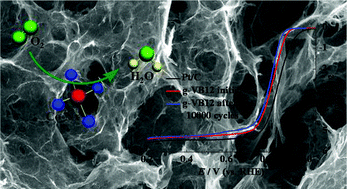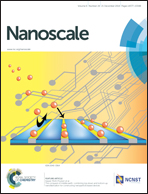A cobalt–nitrogen complex on N-doped three-dimensional graphene framework as a highly efficient electrocatalyst for oxygen reduction reaction†
Abstract
The high cost and limited natural abundance of platinum hinder its widespread applications as the oxygen reduction reaction (ORR) electrocatalyst for fuel cells. Carbon-supported materials containing metals such as Fe or Co as well as nitrogen have been proposed to reduce the cost without obvious lowering the performance compared to Pt-based electrocatalysts. In this work, based on the pyrolyzed corrin structure of vitamin B12 on the simultaneously reduced graphene support (g-VB12), we construct an efficient oxygen reduction electrocatalyst with very positive half-wave potential (only ∼30 mV deviation from Pt/C), high selectivity (electron transfer number close to 4) and excellent durability (only 11 mV shift of the half-wave potential after 10 000 potential cycles). The admirable performance of this electrocatalyst can be attributed to the homogeneous distribution of abundant Co–Nx active sites, and a well-defined three-dimensional mesoporous structure of the N-doped graphene support. The high activity and long-term stability of the low cost g-VB12 make it a promising ORR electrocatalyst in alkaline fuel cells.


 Please wait while we load your content...
Please wait while we load your content...